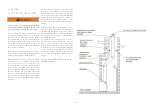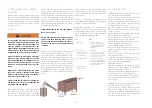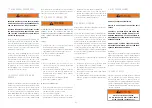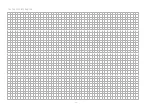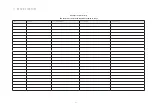
18
6. OPERATION
WARNING
ALWAYS OPERATE THIS APPLIANCE WITH THE
DOOR CLOSED AND LATCHED EXCEPT DURING
START UP AND RE-FUELING. ALWAYS WEAR
GLOVES TO PREVENT INJURY. DO NOT LEAVE THE
FIRE UNATTENDED WHEN THE DOOR IS UNLATCHED
AS UNSTABLE WOOD COULD FALL OUT OF THE FIRE
CHAMBER CREATING A FIRE HAZARD TO YOUR
HOME.
PLEASE USE THE GLOVE THAT IS SUPPLIED WHEN
OPERATING THE INSERT.
NEVER EVER LEAVE CHILDREN UNATTENDED WHEN
THERE IS A FIRE BURNING IN THE APPLIANCE.
NEVER USE GASOLINE, GASOLINE-TYPE LANTERN
FUEL, KEROSENE, CHARCOAL LIGHTER FLUID, OR
SIMILAR LIQUIDS TO START OR ‘FRESHEN UP’ A
FIRE IN THIS APPLIANCE. KEEP ALL SUCH LIQUIDS
WELL AWAY FROM THE APPLIANCE WHILE IT IS IN
USE.
OBJECTS PLACED IN FRONT OF THE APPLIANCE
SHOULD BE KEPT A MINIMUM OF 48” FROM THE
FRONT FACE.
ANY MODIFICATION OF THE APPLIANCE THAT HAS
NOT BEEN APPROVED IN WRITING BY THE TESTING
AUTHORITY IS CONSIDERED BREACHING CSA B365
(CANADA) AND ANSI NFPA 211 (USA).
OPEN AIR CONTROL IF ADJUSTABLE AND DAMPER
IF FITTED BEFORE OPENING FIRING DOOR.
HOT WHILE IN OPERATION. KEEP CHILDREN,
CLOTHING AND FURNITURE AWAY. CONTACT MAY
CAUSE SKIN BURNS. WEAR SUITABLE GLOVES TO
OPERATE YOUR APPLIANCE.
NEVER OPERATE THE STOVE WITH THE GRATE
COVER REMOVED.
DO NOT POKE OR STIR THE LOGS WHILE THEY ARE
BURNING. USE ONLY FIRELOGS THAT HAVE BEEN EVAL-
UATED FOR THE APPLICATION IN WOOD INSERT AND
REFER TO FIRELOG WARNINGS AND CAUTION MARK-
INGS ON PACKAGING PRIOR TO USE.
WARNING
AVOID BURN RISK. REMOVE OPERATIONAL TOOL
AFTER USE!!!
WARNING
PLEASE USE THE GLOVE THAT IS SUPPLIED WHEN
OPERATING THE INSERT!
Your Spartherm product is designed with the most
advanced technology. The appliance is extremely
airtight. It has an exclusive direct outside air supply
(optional kit), a safety feature designed to prevent
spillage, and to keep your house free of carbon monox-
ide, in case of a down drafting chimney or an internal
negative pressure.
The first fire(s) in your appliance will be difficult to
get going and keep going with little amount of heat
being generated. This is a result of the moisture being
driven out of the fire brick. Allow 30 hours of hot fires
(temperatures in excess of 500°F / 260°C - 600°F /
316°C) before your appliance will perform normally.
During the break-in period (the first 2 or 3 fires) create
only small, hot fires using kindling; this will allow the
firebrick to cure. Do not be alarmed if small hairline
cracks develop in the firebrick. This is a normal occur-
rence and does not pose a safety hazard. The paint
may also smell for the first few fires as it cures and It
is recommended to open a door or window to alleviate
the smell.
To start, a brisk fire is required. Place loosely crumpled
paper on the floor of the appliance and cover with dry
kindling. Light the paper and leave the door slightly
ajar (one inch) until all kindling is burning. To maintain
a brisk fire, a hot coal bed must be established and
maintained.
Slowly add larger wood (2x4 size pieces). Lay the
pieces lengthwise from side to side in the hot coal bed
with a shallow trench between, so that the primary air
can flow directly into this trench and ignite the fuel
above. When the fire seems to be at its peak, medium
sized logs may be added. Once these logs have caught
fire, carefully close the door. (Closing the door too
quickly after refuelling will reduce the firebox tempera-
ture and result in an unsatisfactory burn.) Remember
it is more efficient to burn medium sized wood, briskly,
and refuel frequently than to load the appliance with
large logs that result in a smouldering, inefficient fire
and dirty glass. As soon as the door is closed, you will
observe a change in the flame pattern. The flames will
get smaller and lazier because less oxygen is getting
into the combustion chamber. The flames, however, are
more efficient. The flames will remain lazy but become
larger again as soon as the refractory bricks have been
heated thoroughly and the chimney becomes heated
and provides a good draft. At this point, the roaring
fire that you see when the door is opened is wastefully
drawing heated room air up the chimney -- certainly
not desirable. Always operate with the door fully closed
once the medium sized logs have caught fire.
You can now add larger pieces of wood and operate
the appliance normally. Once the appliance is entirely
hot, it will burn very efficiently with little smoke from
the chimney. There will be a bed of orange coals in the
firebox and secondary flames flickering just below the
top firebrick. You can safely fill the firebox with wood
up to the air inlet on the backside of the firebox or,
if not present, up to 50% of the fireboxes backside
height and will get best burns if you keep the appliance
pipe temperatures between 250°F (120°C ) and 450°F
(270°C ). A surface thermometer placed on the front
top will help regulate this.
Without an appliance thermometer, you are working
blindly and have no idea of how the appliance is
operating! An appliance thermometer offers a guide
to performance.
Can’t get the fire going?
Use more kindling and paper. Assuming the chimney
and vent are sized correctly and there is sufficient
combustion air, the lack of sufficiently dry quantities
of small kindling is the problem. Thumb size is a good
gauge for small kindling diameter.
Can’t get heat out of the appliance?
One of two things may have happened. The appliance
door may have been closed prematurely and the appli-
ance itself has not reached optimum temperature.
Reopen the door and/or draft control to re-establish a
brisk fire. The other problem may have been wet wood.
The typical symptom is sizzling wood and moisture
being driven from the wood.
ADJUSTING THE COMBUSTION AIR.
Spartherm Inserts are equipped with an air con-
trol System that is easy and effective to use.
The air control system is designed to give you the
ability to adjust the “COMBUSTION AIR” in such a
way that you have a fire that burns clean and well.
It is important to ensure that the combustion air used
to create a clean burning fire… as per the following
INFORMATION.
Air Wash system: This combustion air is designed
to keep the glass clean and to feed the fire with
combustion air to burn. The further the lever is to
the right the more air is made available for the fire.
As an example this setting would be used when
you first light the fire or when you reload the fire.
Depending on the type of fire that you require you
would adjust the air to either slow down the fire –
moving to the midway mark – or to slow the fire even
more as you move to the left past the midway mark.
It is important not to “choke” the fire – do not starve
the fire of air as it can create smoke and a dirty burn.
It can also result in dirty glass and an inefficient fire.
Secondary Air system: This air is used to burn off
the gases that are released when the fire burns.
The secondary air is also linked to the lever and is
adjusted as you adjust the fire.
Summary of Contents for Insert-600
Page 26: ...26 10 6 FOR YOUR INFORMATION...











